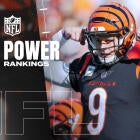The Falcons and Creative Artist Agency's Jimmy Sexton, Julio Jones' agent, are reportedly making progress on the new contract the six-time Pro Bowl wide receiver was promised last summer. The commitment to address Jones' contract this offseason was given when his 2018 salary was increased by $2.9 million while simultaneously reducing his 2019 compensation by the same amount right before Atlanta's training camp opened to avert a holdout.
Atlanta owner Arthur Blank indicated at last week's NFL annual owners meeting the intention was for Jones to be with the Falcons for the rest of his career. He didn't give a timetable for completing a deal.
Jones' contract expires in 2021. He is scheduled to make $21.026 million through the 2020 season, with a salary of $9.6 million this year and $11.426 million in 2020.
Jones appears to be comfortable with the pace of negotiations. He told ESPN's Vaughn McClure he wasn't sure where the talks with Sexton stood but expressed optimism about a new contract. Interestingly, Jones said he didn't care about becoming the NFL's highest paid wide receiver. Ideally for Jones, his contract could be done in a manner that would allow for the core of the team to be kept in intact. Long-term deals for defensive tackle Grady Jarrett, who was designated as a franchise player for $15.209 million, and middle linebacker Deion Jones, who is in the final year of his four-year rookie contract, are also priorities for the Falcons.
Jones didn't commit to participating in the voluntary offseason workout program, which begins on April 15. He didn't attend last offseason. Jones plans on being at mandatory minicamp scheduled for June 11-13, unlike last year.
Player/agent relationship
Topping the wide receiver market may not be important to Jones but probably is to his agent. Sexton changed the non-quarterback market in 2015 by negotiating a blockbuster free-agent deal for defensive tackle Ndamukong Suh ($114.375 million for six years, $59.955 million fully guaranteed) with the Dolphins.
Jones appearing to lack knowledge about the details of his negotiations isn't out of the ordinary, although an agent is supposed to take marching orders from the client and attempt to execute his wishes. An agent works for the player, even though it may sometimes seem as if it's the other way around. Players rarely micromanage a negotiation or give very specific instructions regarding the negotiation process. Some prefer only to know when a deal is imminent or won't get involved in the process again until the final stages of a negotiation, if at all.
Because of this dynamic, an agent is usually given wide latitude to negotiate a contract that he or she feels is in the client's best interest. Jones' comments suggest to me that he and Sexton could be operating in this manner.
Jones' production
Falcons general manager Thomas Dimitroff recently acknowledged that Jones is one of a handful of elite wide receivers that have the ability to be the highest paid in the league. Jones, who turned 30 in February, led the NFL last season with 1,677 yards. His 113 receptions were tied for fourth most in the league, while the eight touchdown receptions he had were his most since 2015.
Jones previously topped the NFL in receiving yards in 2015 when he had a career best 1,871. He cracked the 1,500-yard receiving mark for the third time in his eight-year NFL career last season. The 2018 season was Jones's fifth straight with at least 1,400 receiving yards. It was also the fifth consecutive year he earned All-Pro honors.
Nobody has more receiving yards than Jones' 4,530 since the start of the 2016 season. He is also currently the all-time leader in reception yards per game with 96.7 on average.
The Antonio Brown factor
Odell Beckham, Jr., who was recently traded to the Browns, became the financial benchmark for wide receivers in most key contract metrics last preseason. The Giants signed him to five-year, $90 million contract extension averaging $18 million per year. The deal is worth as much as $95 million through salary escalators based on Beckham performing like he did in his first three NFL seasons, when he averaged 96 catches for 1,374 yards and nearly 12 receiving touchdowns. Beckham's $65 million in overall guarantees is the most ever in a wide receiver contract. $40.959 million was fully guaranteed at signing.
Antonio Brown's contract may be a more important data point in Jones' negotiations than Beckham's. The four-year, $68 million extension Brown signed in 2017 was upgraded in conjunction with his trade from the Steelers to the Raiders last month.
Brown, who will be 31 in July, received an $11.2 million raise over the three remaining years of his contract to bring his total compensation during this span to $50.125 million. None of the $38.925 million in Brown's contract prior to the trade was secure. His adjusted contract has $30.125 million fully guaranteed.
Brown has the potential to earn an additional $4 million through incentives. Up to $2 million can be made in both 2020 and 2021 based on Brown's performance for that season. He earns $500,000 for reaching 100 receptions or 1,200 receiving yards. The amount doubles if the Raiders make the playoffs. Brown gets another $500,000 for hitting 120 catches or 1,400 receiving yards. There's also $500,000 for being named first team All-NFL/All-Pro by the Associated Press.
How to value Brown's contract could be a source of debate. Because Brown received the $11.2 million increase in salary without adding any new years to his contract, the NFLPA and the agent community are viewing the change as an enhancement to the 2017 extension. From the player's side of the equation, Brown has a deal averaging $19.8 million per year since $79.2 million of new money is over his four new contract years since the 2017 signing.
The Falcons may be focusing on the total compensation the Raiders will be paying Brown over the length of his contract. Under this interpretation, Brown has a three-year, $50.125 million deal averaging $16,708,333 per year.
Either way, Brown's cash flow through 2021 will likely be relevant to Sexton. He may also assert that Brown's extension should be looked at as $81.2 million or $20.3 million per year because of the likelihood of him earning at least half of the incentive package based on his past performance. Over the last three seasons, Brown is essentially averaging 104 receptions for 1,371 yards with two first team selections. Since 2013, a typical Brown season is basically 114 receptions with 1,524 receiving yards. Brown's four-year streak of being named AP first-team All-Pro was snapped in 2018.
What Jones' next contract could look like
Taking into consideration the dynamics that have been highlighted, below is a chart breaking down the projected contract between Jones and the Falcons.
- Signing bonus: $25 million ($12.5 million with 10 days of execution; $12.5 million payable on 4/15/2020)
- Guaranteed money: $50.526 million
- Fully guaranteed at signing: $37.526 million
- New money total: $60 million ($81.026 million over 5 years)
- Contract length: Three-year extension
- Average per year: $20 million
| Year | Base Salary | Signing bonus proration | Salary cap number | Cash flow |
|---|---|---|---|---|
| 2019 | $1,100,000 | $8,866,666 | $9,966,666 | $13,600,000 |
| 2020 | $11,426,000 | $6,466,668 | $17,892,668 | $37,526,000 |
| 2021 | $13,000,000 | $5,000,000 | $18,000,000 | $50,526,000 |
| 2022 | $14,500,000 | $5,000,000 | $19,500,000 | $65,026,000 |
| 2023 | $16,000,000 | $5,000,000 | $21,000,000 | $81,026,000 |
- 2019 guaranteed for skill, injury and salary cap
- 2020 guaranteed for skill, injury and salary cap
- 2021 guaranteed for injury; skill and salary cap on third day of 2020 league year
Making sense of the projected contract
It would be a surprise if Jones didn't become the NFL's highest-paid wide receiver notwithstanding him downplaying the significance. Jones isn't showing any signs of slowing down, although he is now 30. He can make a compelling case that he is the league's best wide receiver based on his production and accomplishments in recent years.
The guarantees fall short of Beckham's marks. Beckham has nearly $14.475 million more in overall guarantees. His amount fully guaranteed at signing is almost $3.5 million greater.
Jones' cash flow through 2021 is $401,000 more than Brown's. Brown could ultimately make more than Jones during the three years because of the incentives. The proposed Jones contract doesn't contain any performance bonuses.
The signing bonus payment schedule is consistent with Jones' 2015 extension and Atlanta's other high-end contracts. For example, half of Matt Ryan's $46.5 million signing bonus in the five-year extension signed last May making him the NFL's first $30 million per year player will be paid this April 15.
The Falcons would pick up $3.5 million of 2019 cap room with the renegotiated contract. Jones' 2020 cap number increases by $5 million because of the addition of signing bonus proration with his scheduled salary next year staying the same. The cap numbers in the last four years of the deal are fairly manageable given the size of the contract. There isn't a big variance in those years.
The Falcons could exit the deal in 2022 after Jones' guarantees run out without adverse cap consequences if necessary. There would be a $10 million cap charge from the bonus proration in the final years, which would result in a gain of $9.5 million in cap space. Jones would have earned $29.5 million more than he is scheduled to make under his existing contract for playing one additional year.
Getting 49.2 percent of the new money in the deal through the first new year is a player-friendly structure. It's in line with the three-year, $39 million extension David Johnson signed with the Cardinals right before the start of the 2018 season to help solidify a dramatic reset of the running back market. Johnson is at 48.1 percent through the first new year.
The 2019 cap relief is much needed. Only four NFL teams (Buccaneers, Panthers, Steelers and Vikings) have less than Atlanta's $4.474 million of cap space, according to NFLPA data. Atlanta will pick up $6.45 million of cap room on June 2 when offensive tackle Ryan Schraeder's 2019 salary comes off the books from releasing him with a post-June 1 designation. Roughly $8 million of the nearly $11 million in cap space will be needed for the Falcons to sign their draft class, barring any trades.
Some of the cap room gained from Jones deal could be used for a Deion Jones extension. It will be difficult for him to create his own cap room because his 2019 salary is little more than $1.05 million while his league minimum salary is $720,000. A Jarrett long-term deal has the potential to give the Falcons significant cap room because it's unlikely that his 2019 cap number will be the same as franchise tag number.





















